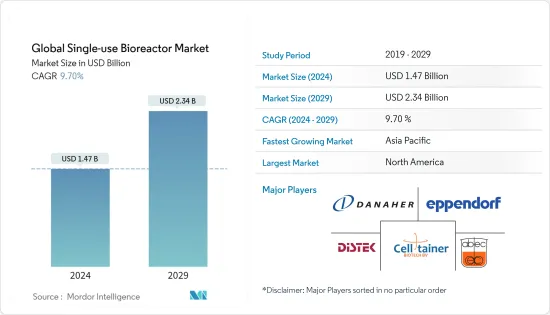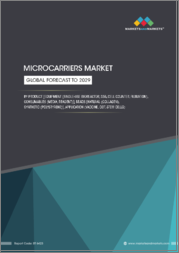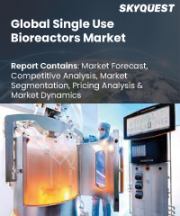
|
시장보고서
상품코드
1437992
세계의 일회용 바이오리액터 시장 : 점유율 분석, 산업 동향 및 통계, 성장 예측(2024-2029년)Global Single-use Bioreactor - Market Share Analysis, Industry Trends & Statistics, Growth Forecasts (2024 - 2029) |
||||||
세계의 일회용 바이오리액터(Single-use Bioreactor) 시장 규모는 2024년 14억 7,000만 달러로 추정되며, 2029년까지 23억 4,000만 달러에 이를 것으로 예측되며, 예측기간(2024-2029년) 동안 9.70%의 CAGR로 추이하며 성장할 전망입니다.

현재 진행 중인 COVID-19 팬데믹은 연구 대상 시장에 상당한 영향을 미칠 것으로 예상됩니다. 팬데믹 초기에는 제조 현장의 가동 중단과 폐쇄로 인해 주요 업체들의 매출이 감소하면서 시장 성장이 저해되었습니다. 예를 들어, 2021년 5월 글로벌 시장 업체 중 하나인 ABEC가 발표한 "COVID가 타격을 주면서 일회용 리드 타임 최대 12개월"이라는 제목의 보도자료에 따르면, 일회용 장비를 최대 1년까지 기다린 제조업체는 거의 없는 반면, 생산 능력을 확장하는 공급업체는 이러한 프로젝트를 온라인화하는 데 수개월이 걸렸습니다. 따라서 일회용 바이오리액터의 판매는 팬데믹의 영향을 받았습니다. 그러나 일회용 바이오 프로세스 재료와 시스템은 가능한 백신과 치료제를 만들고 배포하는 데 필수적인 자원으로 간주되었습니다. 또한 이러한 플랫폼은 mRNA, DNA, 바이러스 벡터와 같은 혁신적인 백신을 만드는 데 사용되었으며, 필요한 속도와 유연성 때문에 일반적으로 일회용 기술을 사용하여 구축되었습니다. 2022년 7월에 발표된 'COVID-19로 일회용 기술의 성장 급증' 기사에서는 바이오 제약 회사들이 SARS-CoV-2 바이러스에 대한 백신을 대량 생산하기 위해 신속하게 온라인에 적용할 수 있는 적응형 기술을 찾았다고 언급했습니다. 그 결과, COVID-19는 일회용 시스템(SUS)의 전환점이 되었고, 산업 제조를 위한 재사용 및 적응형 기술에 대한 수요가 급격히 증가했습니다. 따라서 위에서 언급한 요인들은 COVID-19 팬데믹이 연구 대상 시장에 상당한 영향을 미쳤음을 나타냅니다.
시장 성장을 가속하는 특정 요인으로는 업계의 단일 사용 기술(SUT)의 신속한 채택, 비용 효과, 다운타임 단축, 신제품 출시 등이 있습니다.
또한 일회용 바이오리액터(SUB) 사용에 대한 업계의 성향은 현재 단계의 중요성, 제품의 가치, 제품 개발 및 생산에 소요되는 시간에 영향을 받고 있습니다. 또한, 2022년 7월에 발표된 '업스트림 바이오 제조의 발전: 연속 관류 세포 배양' 기사에 따르면 초기 연속 관류 공정 개발은 배치 및 공급 배치 공정보다 시간이 더 걸리는 경우가 많다고 언급했습니다. 그러나 이 프로세스가 실제로 적용되면 생산성 향상으로 이를 상쇄할 수 있습니다. 이러한 이점에는 제조업체가 생산 운영량 요구 사항을 줄여 임상 생산량에 더 쉽게 도달할 수 있다는 점이 포함됩니다. 그리고 이러한 이점은 일회용 바이오리액터를 사용하여 달성할 수 있습니다. 따라서 일회용 바이오리액터를 사용함으로써 얻을 수 있는 제조 시설의 이러한 장점은 시장 성장에 기여할 것으로 예상됩니다.
바이오 프로세싱 부문에서 SUB는 임상 및 산업 배치의 표준이 되었습니다. 따라서 일회용 바이오리액터 부문에서도 상당한 발전이 이루어지고 있으며, 이는 시장 성장에 박차를 가하고 있습니다. 예를 들어, 2021년 3월에 Thermo Fischer Scientific은 3,000L 및 5,000L HyPerforma DynaDrive 일회용 바이오리액터를 출시했습니다. 이 제품의 3,000L 및 5,000L 용기는 동일한 설치 공간을 가지며, 관류 세포 배양 절차에 단순화되고 최적화된 하드웨어로 제조실 공간을 절약하는 데 도움이 됩니다. 따라서 이러한 개발은 예측 기간 동안 시장 성장을 주도할 것으로 예상됩니다.
따라서 위에서 언급 한 요인으로 인해 시장은 예측 기간 동안 성장할 것으로 예상됩니다. 그러나 높은 정기 반복 비용이 수반되어 시장 성장을 저해 할 것으로 예상됩니다.
일회용 바이오리액터 시장 동향
단클론항체 부문 성장이 기대
림프종, 백혈병, 자가 면역 질환 등 여러 질병 치료에 단일 클론 항체(MAb)를 사용하는 주요 장점은 생물학적 공급원에서 추출하여 장기적으로 항체를 생산할 수 있다는 것입니다. 일회용품(일회용 바이오리액터)을 사용하면 세척 및 멸균 단계와 세척 검증이 필요하지 않으므로 배치당 비용과 운영 시간을 줄일 수 있습니다. 따라서 MAb 제조에 대한 수요가 증가함에 따라 MAb의 생산 및 제조를 위한 일회용 바이오리액터(SUB)의 적용도 증가하고 있습니다. 따라서이 부문의 성장을 주도 할 것으로 예상됩니다.
새로운 백신 및 치료제에 대한 수요 급증, 만성 및 전염병 증가와 함께 연구 개발 (R&D) 활동, 협업 및 전략적 파트너십의 증가는이 부문의 성장을 촉진 할 것으로 예상됩니다. 예를 들어, 2022년 1월, HaemaLogiX Ltd(이하 HaemaLogiX)와 론자는 정상 혈장 세포가 아닌 골수종 암세포에서만 발견되는 카파 골수종 항원(KMA)이라는 세포 표면 표적에 결합하는 단일클론 항체인 카파맙의 차기 임상 배치(cGMP) 제조 계약을 체결한 바 있습니다. 이러한 단일 클론 항체 개발 전략은 제조 시설에 사용되는 SUB에 대한 수요를 창출하여 해당 부문의 성장을 견인할 것으로 예상됩니다.
게다가 2022년 7월에 53Biologics가 발표한 기사에서는 매년 식품의약국(FDA)에 의한 신약 승인의 약 5분의 1을 단클론항체 바이오의약품이 차지하고 있으며, SUB 등의 바이오리액터는 MAb 제조의 효율 그리고 성능을 향상시킬 수 있다고 말합니다. 따라서 MAb 제조에서 SUB의 효율성과 성능이 향상됨에 따라 부문 성장이 촉진될 것으로 예상됩니다.
따라서 위의 요인으로 인해 이 부문은 예측 기간 동안 성장할 것으로 예상됩니다.
북미가 시장을 독점하고 있으며 예측기간 동안에도 그럴 것으로 예상
북미는 만성 질환 증가와 더불어 신약 개발의 필요성이 증가함에 따라 일회용 바이오리액터(SUB) 시장에서 지배적인 지역이 될 것으로 예상됩니다.
2022년 1월 10일에 발표된 미국 질병통제예방센터의 데이터에 따르면 미국인 3,420만 명 이상이 당뇨병을 앓고 있으며 매년 868,000명 이상이 심장 질환으로 사망하고 있습니다. 이 외에도 미국 식품의약국(FDA)에서 업데이트한 '팩트 시트: FDA 한눈에 보기'에 따르면 2021년 11월에 발표된 자료에 따르면 생물학적 제제 개발을 위한 FDA 등록 시설은 4,944개, 인간 의약품을 위한 시설은 6,799개에 달합니다. 이처럼 의약품을 생산하는 제조 시설이 많다는 것은 SUB를 사용할 수 있는 기회를 창출할 것으로 예상됩니다. 따라서 이 지역의 시장 성장을 견인할 것으로 예상됩니다.
또한 제약 및 바이오 제약 산업의 혁신적인 신약 개발은이 부문의 시장 확대를 촉진 할 것으로 예상됩니다. 국제 제약 제조업체 및 협회 연맹의 '2021 팩트&피규어 보고서'에 따르면 2021년 2월 현재 약 382개의 백신 후보가 개발 중이며, 이 중 24개가 1상, 34개가 2상, 23개가 3상 시험 중입니다. 바이오 제약 업계는 환자들에게 백신을 공급하기 위해 비상하고 신속한 조치를 취하고 있습니다. 따라서 국내 생물학적 제제 개발에 대한 이러한 수요 증가는 예측 기간 동안 일회용 바이오리액터 사용에 대한 수요를 창출 할 것으로 예상됩니다.
또한 개발과 제품 출시는 이 나라 시장 성장을 가속할 것으로 기대됩니다. 예를 들어, 2021년 10월에 미국을 둔 기업인 Agilitech사는 30L에서 최대 2000L까지 최대 2대의 일회용 바이오리액터를 동시에 제어할 수 있는 Agilitech 바이오리액터 컨트롤러를 출시했습니다. 이 제품의 설계로 통합이 가능합니다. 모든 브랜드의 일회용 바이오리액터를 사용할 수 있습니다. 제약 및 바이오의약품 사업에서 이러한 발전은 시장 확대를 추진하고 있으며, 예측 연도 동안 국내 조사 대상 시장 성장에 긍정적인 영향을 미칠 것으로 예상됩니다.
일회용 바이오리액터 산업 개요
일회용 바이오리액터 시장 경쟁 구도에는 비즈니스 개요, 재무, 제품 및 전략, 지역 및 세계 시장 기업의 최근 동향이 포함됩니다. 세계의 일회용 바이오리액터 시장은 경쟁이 심하고 많은 주요 기업으로 구성되어 있습니다. ABEC, Celltainer, Distek Inc., Eppendorf AG, Danaher(Cytiva), Merck KGaA, OmniBRx Biotechnologies, Pall Corporation, Sartorius AG, Thermo Fisher Scientific 등의 기업이 일회용 바이오리액터 시장에서 큰 점유율을 차지하고 있습니다.
기타 혜택
- 엑셀 형식 시장 예측(ME) 시트
- 3개월의 애널리스트 서포트
목차
제1장 서론
- 조사 전제 조건 및 시장 정의
- 조사 범위
제2장 조사 방법
제3장 주요 요약
제4장 시장 역학
- 시장 개요
- 시장 성장 촉진 요인
- 업계에 의한 일회용 테크놀로지(SUT)의 급속한 도입
- 비용 효율과 다운타임 단축
- 신제품 발매
- 시장 성장 억제 요인
- 높은 정기 반복 비용
- 적정 제조 기준을 만족시키는 문제
- Porter's Five Forces 분석
- 신규 참가업체의 위협
- 구매자의 협상력
- 공급기업의 협상력
- 대체 제품의 위협
- 기업 간 경쟁 정도
제5장 시장 세분화
- 제품 유형별
- 일회용 바이오리액터 시스템
- 미디어 백
- 여과 조립
- 기타 제품
- 세포 유형별
- 포유류 세포
- 박테리아
- 효모
- 기타 세포 유형
- 분자 유형별
- 백신
- 단클론항체
- 줄기세포
- 재조합 단백질
- 기타 분자 유형
- 최종 사용자별
- 제약 및 바이오의약품산업
- 수탁연구기관(CRO)
- 기타 최종 사용자
- 지역별
- 북미
- 미국
- 캐나다
- 멕시코
- 유럽
- 독일
- 영국
- 프랑스
- 이탈리아
- 스페인
- 기타 유럽
- 아시아 태평양
- 중국
- 일본
- 인도
- 호주
- 한국
- 기타 아시아 태평양
- 중동 및 아프리카
- GCC
- 남아프리카공화국
- 기타 중동 및 아프리카
- 남미
- 브라질
- 아르헨티나
- 기타 남미
- 북미
제6장 경쟁 구도
- 기업 개요
- ABEC
- Celltainer
- Distek, Inc.
- Eppendorf SE
- Danaher(Cytiva)
- Merck KGaA
- OmniBRx Biotechnologies
- Pall Corporation
- Sartorius AG
- Thermo Fisher Scientific
제7장 시장 기회 및 향후 동향
LYJThe Global Single-use Bioreactor Market size is estimated at USD 1.47 billion in 2024, and is expected to reach USD 2.34 billion by 2029, growing at a CAGR of 9.70% during the forecast period (2024-2029).

The ongoing Covid-19 pandemic is expected to have a significant impact on the studied market. The market growth was hampered by the decline in sales by major players in the initial phase of the pandemic due to the shutdown and closure of the manufacturing sites. For instance, according to a press release titled "Single-use Lead Times up to 12 Months as COVID Takes Its Toll" by one of the global market players ABEC in May 2021, few manufacturers have waited up to 1 year for single-use equipment, while vendors who are expanding capacities, these projects took months to come online. Thus, the sales of single-use bioreactors were affected by the pandemic. However, single-use bioprocess materials and systems were considered essential resources for the creation and distribution of possible vaccines and treatments for the disease. And, these platforms were used to make innovative vaccines, such as mRNA, DNA, and viral vectors, and were generally constructed using single-use technologies due to the speed and flexibility required. In the article 'COVID-19 Drives Surge in Growth of Single-use Technologies' published in July 2022 it was mentioned that biopharmaceutical companies sought out adaptable technologies that could be swiftly brought online to mass produce vaccines against the SARS-CoV-2 virus. As a result, COVID-19 marked a turning point for single-use systems (SUS), with a sharp rise in demand for reusable and adaptable technology for industrial manufacture. Therefore, such factors mentioned above indicate that the Covid-19 pandemic has had a significant impact on the market studied.
Certain factors that are driving the market's growth include rapid adoption of single-use technologies (SUTs) by the industry, cost-effectiveness, lower downtime, and the launch of new products.
Furthermore, the inclination of the industry toward using singleuse bioreactors (SUBs) is currently being influenced by the criticality of the step, the value of the product, and the time for product development and production. Additionally, as per the article 'Advancing upstream biomanufacturing: continuous perfusion cell culture' published in July 2022 it was mentioned that initial continuous perfusion process development frequently takes more time than batch and fed-batch processes. However, once the procedure is in practice, productivity gains might counterbalance this. These benefits include enabling manufacturers to reach clinical production quantities more readily by allowing for lesser scale-up production operational volume requirements. And these benefits can be achieved using single-use bioreactors. Therefore, such advantages in manufacturing facilities that are gained by using single-use bioreactors are anticipated to contribute to market growth.
In the bioprocessing sector, SUBs has become a standard for both clinical and industrial batches. Thus, significant developments are being made in the single-use bioreactor segment which is also fuelling the market growth. For instance, in March 2021, Thermo Fischer Scientific launched the 3,000 L and 5,000 L HyPerforma DynaDrive single-use bioreactors. The 3,000 L and 5,000 L vessels in this product have the same footprint, with hardware that is simplified and optimized for perfusion cell culture procedures to assist conserve manufacturing suite space. Thus, such developments are anticipated to drive market growth over the forecast period.
Therefore, owing to the above-mentioned factors the market is predicted to witness growth over the forecast period. However, high regular recurring expenses may be involved which is anticipated to hinder the market growth.
Single Use Bioreactor Market Trends
Monoclonal Antibodies Segment is Anticipated to Witness Growth
The main advantage of using monoclonal antibodies (MAbs) in treating several diseases (such as lymphoma and leukemia, as well as autoimmune diseases) is that they are taken from a biological source and can produce antibodies in the long term. While the use of disposables (single-use bioreactors) eliminates cleaning and sterilization steps, as well as cleaning validation, it reduces cost and the time of operation per batch. Thus, with the increasing demand for MAbs manufacturing, the application of single-use bioreactors (SUBs) for the production and manufacturing of MAb is also increasing. Hence, it is expected to drive the growth of the segment.
An increase in research and development (R&D) activities, collaborations, and strategic partnerships along with soaring demand for new vaccines and therapeutics and rising chronic and infectious diseases is expected to boost the segment growth. For instance, in January 2022, HaemaLogiX Ltd (HaemaLogiX) and Lonza entered into an agreement to manufacture the next clinical batch (cGMP) of HaemaLogiX's lead multiple myeloma drug candidate, KappaMab, a monoclonal antibody that binds to a cell surface target called kappa myeloma antigen (KMA) that is only found on myeloma cancer cells and not on normal plasma cells. Such strategies for the development of monoclonal antibodies are anticipated to create demand for SUBs used for manufacturing facilities, thereby, expected to drive segment growth.
Moreover, an article published by 53Biologics in July 2022 stated that monoclonal antibody biotherapeutics account for roughly 1/5th of new drug approvals by the Food and Drug Administration (FDA) every year, and bioreactors such as SUBs can improve efficiency and performance in MAb manufacturing. Thus, the improved efficiency and performance of SUBs in manufacturing of MAb are expected to boost the segment growth.
Therefore, owing to the factors mentioned above, the segment is anticipated to witness growth over the forecast period.
North America Dominates the Market and is Expected to do so during the Forecast Period
North America is expected to be a dominant region in the single-use bioreactors (SUBs) market due to increasing chronic illnesses coupled with the emerging need for developing new drugs.
More than 34.2 million Americans have diabetes, and more than 868,000 people die from heart disease each year, according to data from the Centers for Disease Control and Prevention that was published on January 10th, 2022. In addition to this, the data updated by the Food and Drug Administration (FDA) in 'Fact Sheet: FDA at a Glance' published in November 2021 shows that there are 4,944 FDA-Registered Facilities for the development of biologics and 6,799 for human drugs. Such a high number of manufacturing facilities to produce drugs is expected to create opportunities for the use of SUBs. Thereby, expected to drive market growth in the region.
Furthermore, the pharmaceutical and biopharmaceutical industries' innovative drug development is anticipated to fuel market expansion in this sector. About 382 vaccine candidates were under development as of February 2021, according to the International Federation of Pharmaceutical Manufacturers and Associations' "Facts & Figures Report 2021," of which 24 were in Phase I, 34 were in Phase II, and 23 were in Phase III trials. The biopharmaceutical sector is taking extraordinary, quick steps to get vaccinations to patients. Thus, such increasing demand for the development of biologics in the country is expected to create demand for the use of single-use bioreactors over the forecast period.
Moreover, the developments and product launches are also expected to drive market growth in the country. For instance, in October 2021, the Agilitech bioreactor controller was launched by Agilitech, a United States-based company that provides simultaneous control of up to two single-use bioreactors from 30 L up to 2000 L. The design of the product allows for integration with any brand single-use bioreactor. Such developments in the pharmaceutical and biopharmaceutical businesses are driving market expansion and are anticipated to favorably affect the growth of the studied market in the country during the projected year.
Single Use Bioreactor Industry Overview
The competitive landscape of the single-use bioreactors market covers the business overview, financials, products and strategies, and recent developments by market players regionally and globally. The global single-use bioreactor market is competitive and consists of a number of major players. Companies, like ABEC, Celltainer, Distek Inc., Eppendorf AG, Danaher (Cytiva), Merck KGaA, OmniBRx Biotechnologies, Pall Corporation, Sartorius AG, and Thermo Fisher Scientific, among others, hold substantial shares in the single-use bioreactor market.
Additional Benefits:
- The market estimate (ME) sheet in Excel format
- 3 months of analyst support
TABLE OF CONTENTS
1 INTRODUCTION
- 1.1 Study Assumptions and Market Definition
- 1.2 Scope of the Study
2 RESEARCH METHODOLOGY
3 EXECUTIVE SUMMARY
4 MARKET DYNAMICS
- 4.1 Market Overview
- 4.2 Market Drivers
- 4.2.1 Rapid Adoption of Single-use Technologies (SUTs) by the Industry
- 4.2.2 Cost Effectiveness and Lower Downtime
- 4.2.3 New Product Launches
- 4.3 Market Restraints
- 4.3.1 High Regular Recurring Expenses
- 4.3.2 Issues with Meeting the Standards of Good Manufacturing Practices
- 4.4 Porter's Five Forces Analysis
- 4.4.1 Threat of New Entrants
- 4.4.2 Bargaining Power of Buyers/Consumers
- 4.4.3 Bargaining Power of Suppliers
- 4.4.4 Threat of Substitute Products
- 4.4.5 Intensity of Competitive Rivalry
5 MARKET SEGMENTATION (Market Size by Value - USD million)
- 5.1 By Type of Product
- 5.1.1 Single-use Bioreactor Systems
- 5.1.2 Media Bags
- 5.1.3 Filtration Assemblies
- 5.1.4 Other Products
- 5.2 By Cell Type
- 5.2.1 Mammalian Cell
- 5.2.2 Bacteria
- 5.2.3 Yeast
- 5.2.4 Other Cell Types
- 5.3 By Molecule Type
- 5.3.1 Vaccines
- 5.3.2 Monoclonal Antibodies
- 5.3.3 Stem Cells
- 5.3.4 Recombinant Proteins
- 5.3.5 Other Molecule Types
- 5.4 By End User
- 5.4.1 Pharmaceutical and Biopharmaceutical Industries
- 5.4.2 Contract Research Organizations (CRO)
- 5.4.3 Other End Users
- 5.5 Geography
- 5.5.1 North America
- 5.5.1.1 United States
- 5.5.1.2 Canada
- 5.5.1.3 Mexico
- 5.5.2 Europe
- 5.5.2.1 Germany
- 5.5.2.2 United Kingdom
- 5.5.2.3 France
- 5.5.2.4 Italy
- 5.5.2.5 Spain
- 5.5.2.6 Rest of Europe
- 5.5.3 Asia-Pacific
- 5.5.3.1 China
- 5.5.3.2 Japan
- 5.5.3.3 India
- 5.5.3.4 Australia
- 5.5.3.5 South Korea
- 5.5.3.6 Rest of Asia-Pacific
- 5.5.4 Middle East and Africa
- 5.5.4.1 GCC
- 5.5.4.2 South Africa
- 5.5.4.3 Rest of Middle East and Africa
- 5.5.5 South America
- 5.5.5.1 Brazil
- 5.5.5.2 Argentina
- 5.5.5.3 Rest of South America
- 5.5.1 North America
6 COMPETITIVE LANDSCAPE
- 6.1 Company Profiles
- 6.1.1 ABEC
- 6.1.2 Celltainer
- 6.1.3 Distek, Inc.
- 6.1.4 Eppendorf SE
- 6.1.5 Danaher (Cytiva)
- 6.1.6 Merck KGaA
- 6.1.7 OmniBRx Biotechnologies
- 6.1.8 Pall Corporation
- 6.1.9 Sartorius AG
- 6.1.10 Thermo Fisher Scientific

















